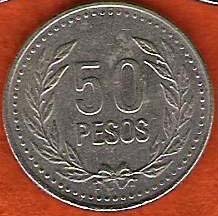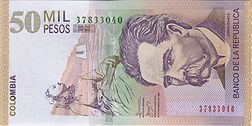|


The peso is the currency of the Republic of Colombia. Its ISO 4217 code is COP and it is also informally abbreviated as COL$. However, the official peso symbol is $. See Currency of Colombia for more detail on Colombia's monetary history. As of February 5th, 2010, the exchange rate of the Colombian Peso is 1,960 Colombian Pesos to 1 U.S. dollar.
History
The peso has been the currency of Colombia since 1837. It replaced the real at a rate of 1 peso = 8 reales and was initially subdivided into 8 reales. In 1847, Colombia decimalized and the peso was subdivided into ten reales, each of 10 decimos de reales. The real was renamed the decimo in 1853, although the last real coins were struck in 1880. The current system of 100 centavos to the peso was first used in 1819 on early banknotes but did not reappear until the early 1860s on banknotes and was not used on the coinage until 1872.
In 1871, Colombia went on to the gold standard, pegging the peso to the French franc at a rate of 1 peso = 5 francs. This peg only lasted until 1886. From 1888, printing press inflation caused Colombia's paper money (pegged to the British pound at a rate of 4300 pesos = 1 pound) to depreciate? and the exchange rate between coins and paper money was fixed at 100 peso moneda corriente = 1 coinage peso. Between 1907 and 1914, coins were issued denominated in "peso p/m", equal to paper pesos. In 1910, the Junta de Conversion began issuing paper money and, in 1915, a new paper currency was introduced, the peso oro. This was equal to the coinage peso and replaced the old peso notes at a rate of 100 old paper pesos = 1 peso oro. In 1931, when the U.K. left the gold standard, Colombia shifted its peg to the U.S. dollar, at a rate of 1.05 pesos = 1 dollar, a slight devaluation from its previous peg.
Although it never appeared on coins, Colombia's paper money continued to be issued denominated in peso oro until 1993, when the word oro was dropped. Since 2001, the Colombian senate has debated whether to redenominate the currency by introducing a new peso worth 1000 old pesos. Such a plan has yet to be adopted.
Coins
Between 1837 and 1839, the Republic of New Grenada introduced silver ¼, ½, 1, 2 & 8 real coins along with gold 1, 2 & 16 pesos. These were mostly continuations of coins issued before 1837 in the name of the Republic of Colombia but with the escudo denominations replaced by pesos. In 1847, the currency was decimalized and coins were introduced in denominations of ½ and 1 decimo de real in copper and 1, 2, 8 and 10 reales in silver. ¼ & ½ real coins followed in 1849 and 1850. In 1853, silver ½ and 1 decimo & gold 10 peso coins were introduced, followed by 2 decimos in 1854 & 1 peso in 1855, both in silver. In 1856, gold 5 peso coins were added.
Between 1859 and 1862, coins were issued by the Grenadine Confederation in silver for ¼, ½ and 2 reales, ¼, ½ and 1 decimo, and 1 peso, and in gold for 1, 2, 5, 10 and 20 pesos. The United States of New Grenada issued silver 1 decimo & 1 peso in 1861.
Beginning in 1862, coins were issued by the United States of Colombia. Silver coins were struck in denominations of ¼, ½, 1, 2 & 5 decimos and 1 peso, together with gold 1, 2, 5, 10 and 20 pesos. With the introduction of the centavo in 1872, silver 2½, 5, 10, 20 & 50 centavos were issued, followed by cupro-nickel 1¼ centavos in 1874 & cupro-nickel 2½ centavos in 1881.
In 1886, the country's name reverted to the Republic of Colombia. The first issues were cupro-nickel 5 centavos. Except for silver 50 centavos (also denominated 5 decimos) issued between 1887 and 1889, no other denominations were issued until 1897, when silver 10 and 20 centavos were introduced. Silver 5 centavos were issued in 1902
In 1907, following the stabilization of the paper money, cupro-nickel 1, 2 and 5 pesos p/m were introduced and issued until 1916. In 1913, after the pegging of the peso to sterling, gold 2½ and 5 peso coins were introduced which were of the same weight and composition as the half sovereign and sovereign. Gold 10 pesos were also issued in 1919 and 1924, with the 2½ and 5 pesos issued until 1929 and 1930, respectively.
In 1918, the 1, 2 and 5 pesos p/m coins were replaced by 1, 2 and 5 centavo coins of the same size and composition. In 1942, bronze 1 and 5 centavo coins were introduced, followed by bronze 2 centavos in 1948. Between 1952 and 1958, cupro-nickel replaced silver in the 10, 20 and 50 centavos.
In 1967, copper-clad-steel 1 and 5 centavos were introduced, together with nickel-clad-steel 10, 20 and 50 centavos and cupro-nickel 1 peso coins, the 2 centavos having ceased production in 1960. In 1977, bronze 2 pesos were introduced. In 1984, production of all coins below 1 peso ended. Higher denominations were introduced in the following years of high inflation. 5 peso coins were introduced in 1980, followed by 10 pesos in 1981, 20 pesos in 1982, 50 pesos in 1986, 100 pesos in 1992, 200 pesos in 1994, 500 pesos in 1993 and 1000 pesos in 1996. However, due to massive counterfeiting problems, the 1000 pesos was withdrawn by stages. By 2002, the coin was out of circulation.
Banknotes
Between 1857 and 1880, five of Colombia's then provinces, Bolivar, Cauca, Cundinamarca, Panama and Santander issued paper money. Denominations included 10 and 50 centavos, 1, 2, 3, 5, 10, 50 and 100 pesos.
In the early 1860s, the Tesori General de los Estados Unidos de Nueva Granada issued notes in denominations of 20 centavos, 1, 2, 3, 10, 20 and 100 pesos, with all denominations also given in reales. In 1863, Treasury notes of the Estados Unidos de Colombia were introduced for 5, 10 and 20 centavos, 1, 2, 5, 10, 20 and 50 pesos.
More than sixty private banks issued notes between 1865 and 1923. Denominations issued included 10, 20, 25, 50 centavos, 1, 2, 5, 10, 20, 25, 50, 100 and 500 pesos. Uniquely, the Banco de Colombia issued notes denominated in both pesos and sterling, due to the peg of 1 peso = 4 shillings.
In 1881, the Banco Nacional introduced notes for 20 centavos, 1, 5, 10, 20, 50 and 100 pesos. These were followed by 50 centavo notes in 1882 and 10 centavos in 1885. 1000 peso notes were introduced in 1895 and 500 pesos in 1900. In 1904, the Treasury took over paper money production, issuing 1, 2, 5, 10, 25, 50 and 100 peso notes, followed by 1000 pesos in 1908. In 1910, the Junta de Conversion introduced 50 and 100 peso notes, followed by 1, 2, 5 and 10 pesos in 1915.
Regional issues were reintroduced in 1898 and were issued until 1920. Antioquia, Bolivar, Magdalena, Santander and Tolima issued notes, with denominations including 10, 20, 50 centavos, 1, 2½, 5, 10, 20 and 50 pesos.
In 1923, the Banco de la Republica took over paper money production and introduced notes denominated in peso oro. The first were provisional issues, overprinted on earlier notes of the Casa de Moneda de Medellin, in denominations of 2½, 5, 10 and 20 pesos. Regular issues followed for 1, 2, 5, 10, 50, 100 and 500 pesos oro. 20 peso notes were introduced in 1927.
In 1932 and 1941, silver certificates were issued for 1 and 5 pesos plata, although 1 and 5 peso oro notes continued to be produced. Treasury notes for 5 and 10 pesos oro were issued in 1938, followed by ½ pesos oro between 1948 and 1953. ½ peso oro notes were also produced by the Banco de la Republica in 1943 by cutting in half 1 peso notes.
The Banco de la Republica introduced 200 and 1000 peso oro notes in 1974 and 1979, respectively, whilst 1 and 2 peso oro notes ceased production in 1977, followed by 10 pesos oro in 1980, 5 pesos oro in 1981, 20 pesos in 1983 and 50 pesos in 1986. 500 peso oro notes were introduced in 1986 with 10,000 pesos oro following in 1992. Production of 100 peso oro notes ended in 1991, followed by that of the 200 and 500 pesos oro in 1992 and 1993, respectively. From 1993, the word oro was dropped. 20,000 peso notes were introduced in 1996 and 50,000 pesos in 2000.
On November 17, 2006, the 1000 and 2000 peso notes were reduced in size from 70×140 to 65×130 mm, because these notes are frequently replaced due to heavy use.
The text on this page has been made available under the Creative Commons Attribution-ShareAlike License and Creative Commons Licenses
|
